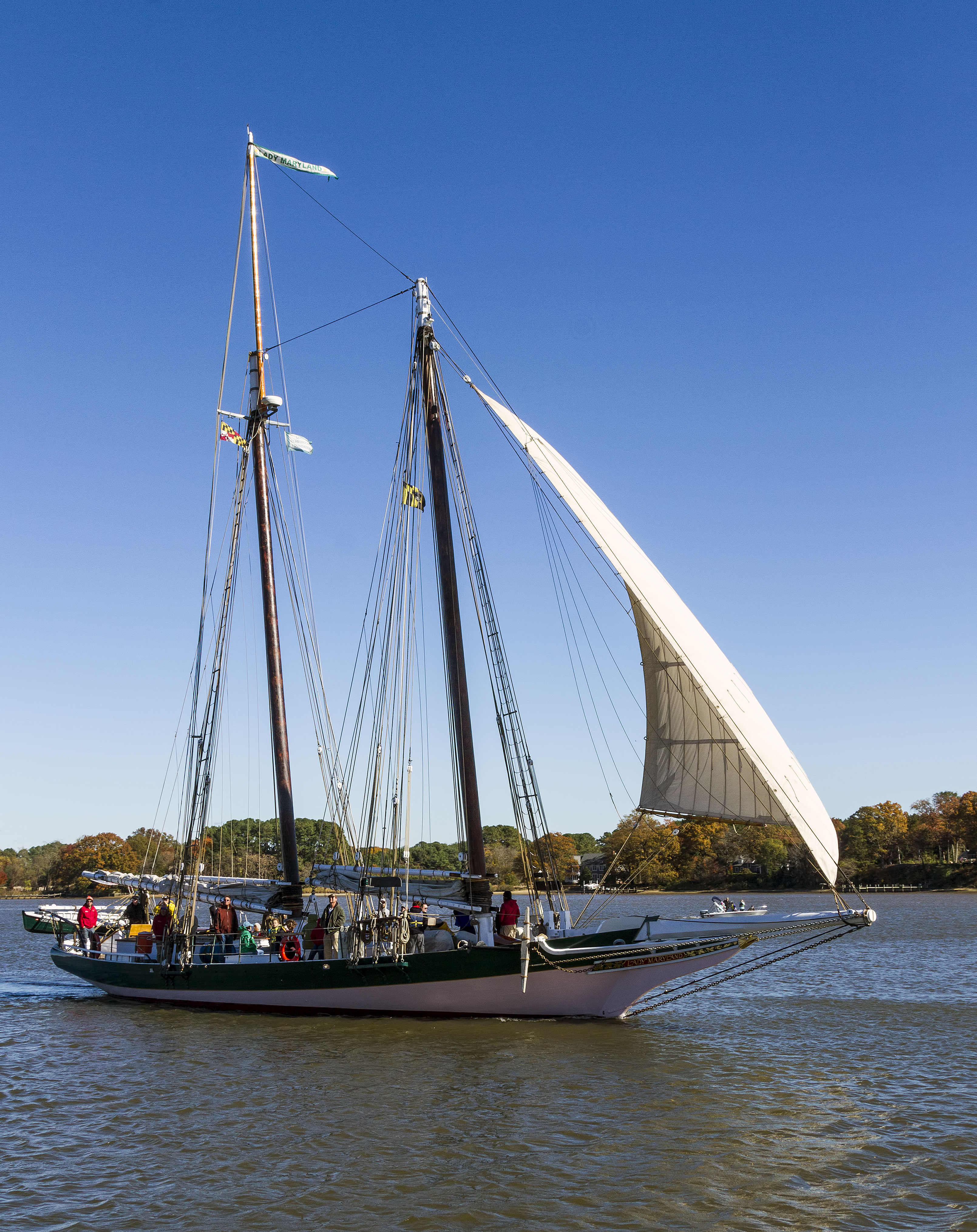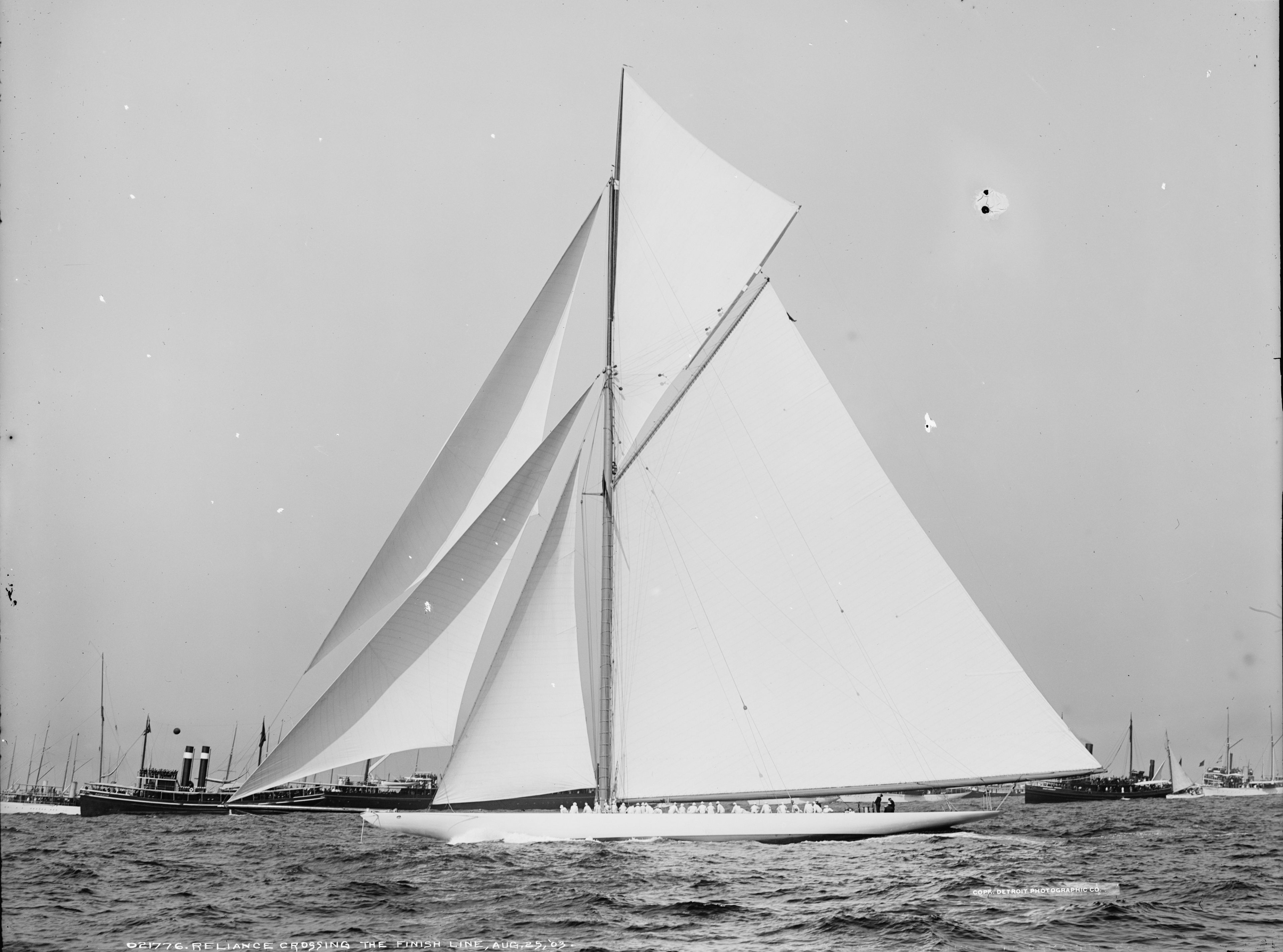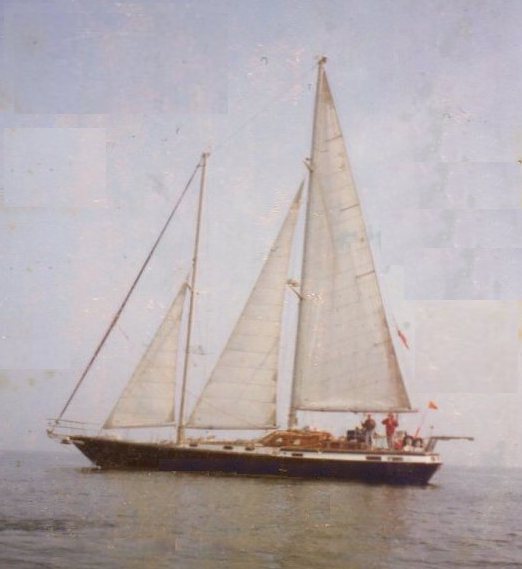|
Bugeye
The bugeye is a type of sailboat developed in the Chesapeake Bay for oyster dredging. The predecessor of the skipjack, it was superseded by the latter as oyster harvests dropped. Origins Between 1820 and 1865, the state of Maryland banned the practice of dredging for oysters. In the latter year, the law was relaxed; the use of steam power remained banned, however, and remained entirely prohibited until 1965, in which year powered dredging was allowed two days of the week. As long as dredging for oysters in the Chesapeake was prohibited, oystermen working from log canoes tonged for oysters. In 1854 the Maryland legislature permitted the use of dredges in the waters of Somerset County, Maryland, expanding the use of dredges to the rest of the Bay following the Civil War. Opening the Chesapeake to oyster dredging after the Civil War created a need for larger, more powerful boats to haul dredges across the oyster beds. The first vessels used were the existing sloops, pungys ... [...More Info...] [...Related Items...] OR: [Wikipedia] [Google] [Baidu] |
Skipjack (boat)
The skipjack is a traditional fishing boat used on the Chesapeake Bay for oyster dredging. It is a sailboat which succeeded the bugeye as the chief oystering boat on the bay, and it remains in service due to laws restricting the use of powerboats in the Maryland state oyster fishery. Design and construction The skipjack is sloop-rigged, with a sharply raked mast and extremely long boom (typically the same length as the deck of the boat). The mainsail is ordinarily triangular, though gaff rigged examples were built. The jib is self-tending and mounted on a bowsprit. This sail plan affords the power needed to pull the dredge, particularly in light winds, while at the same time minimizing the crew required to handle the boat. The hull is wooden and V-shaped, with a hard chine and a square stern. In order to provide a stable platform when dredging, skipjacks have very low freeboard and a wide beam (averaging one third the length on deck). A centerboard is mounted in lieu of a ... [...More Info...] [...Related Items...] OR: [Wikipedia] [Google] [Baidu] |
Skipjack (boat)
The skipjack is a traditional fishing boat used on the Chesapeake Bay for oyster dredging. It is a sailboat which succeeded the bugeye as the chief oystering boat on the bay, and it remains in service due to laws restricting the use of powerboats in the Maryland state oyster fishery. Design and construction The skipjack is sloop-rigged, with a sharply raked mast and extremely long boom (typically the same length as the deck of the boat). The mainsail is ordinarily triangular, though gaff rigged examples were built. The jib is self-tending and mounted on a bowsprit. This sail plan affords the power needed to pull the dredge, particularly in light winds, while at the same time minimizing the crew required to handle the boat. The hull is wooden and V-shaped, with a hard chine and a square stern. In order to provide a stable platform when dredging, skipjacks have very low freeboard and a wide beam (averaging one third the length on deck). A centerboard is mounted in lieu of a ... [...More Info...] [...Related Items...] OR: [Wikipedia] [Google] [Baidu] |
Log Canoe
The log canoe is a type of sailboat developed in the Chesapeake Bay region. Based on the dugout, it was the principal traditional fishing boat of the bay until superseded by the bugeye and the skipjack. However, it is most famous as a racing sailboat, and races continue to be held. History The history of the log canoe is closely tied to the development of the oystering industry on the bay. In pre-power days, the log canoe was an inexpensive craft which could be assembled without recourse to shipbuilders; before the dredge was made legal in 1865, the log canoe was sufficient to the needs of oyster tongers. It did not have the pulling power necessary for dredging, however, its log construction was combined with characteristics of other vessels to form the first bugeyes, a much larger and more powerful vessel. As motor power became available, watermen who were not dredging gradually abandoned sail power; also, the supplies of suitable timber were gradually exhausted. Log canoes w ... [...More Info...] [...Related Items...] OR: [Wikipedia] [Google] [Baidu] |
Ketch
A ketch is a two- masted sailboat whose mainmast is taller than the mizzen mast (or aft-mast), and whose mizzen mast is stepped forward of the rudder post. The mizzen mast stepped forward of the rudder post is what distinguishes the ketch from a yawl, which has its mizzen mast stepped aft of its rudder post. In the 19th and 20th centuries, ketch rigs were often employed on larger yachts and working watercraft, but ketches are also used as smaller working watercraft as short as 15 feet, or as small cruising boats, such as Bill Hanna's Tahiti ketches or L. Francis Herreshoff's Rozinante and H-28. The name ketch is derived from ''catch''. The ketch's main mast is usually stepped further forward than the position found on a sloop. The sail plan of a ketch is similar to that of a yawl, on which the mizzen mast is smaller and set further back. There are versions of the ketch rig that only has a mainsail and a mizzen, in which case they are referred to as ''cat ketch''. More commonl ... [...More Info...] [...Related Items...] OR: [Wikipedia] [Google] [Baidu] |
Brown Smith Jones
The ''Brown Smith Jones'' was a patrol boat of the Maryland State Fishery Police which also served in the United States Navy as a patrol vessel from 1917 to 1918. It was built in 1894 and took its name from the last names respectively of the governor, the state comptroller, and the state treasurer. The design was that of a Chesapeake Bay bugeye, a type of oyster-dredging boat, but with an enlarged cabin replacing the equipment for handling the dredge. She was equipped with a one-pound repeating rifle mounted before the foremast. The U.S. Navy acquired her on 24 August 1917 for World War I service as a patrol vessel and she was commissioned the same day as the USS ''Dorchester'' (SP-1509).. She served in the 5th Naval District for the remainder of World War I, patrolling waters in Maryland and Virginia. The Navy decommissioned her and returned her to the state on 26 November 1918. In the early 1930s the ship was sold to H. K. Rigg and converted to a yacht A yacht is a s ... [...More Info...] [...Related Items...] OR: [Wikipedia] [Google] [Baidu] |
Chesapeake Bay
The Chesapeake Bay ( ) is the largest estuary in the United States. The Bay is located in the Mid-Atlantic (United States), Mid-Atlantic region and is primarily separated from the Atlantic Ocean by the Delmarva Peninsula (including the parts: the Eastern Shore of Maryland / Eastern Shore of Virginia and the state of Delaware) with its mouth of the Bay at the south end located between Cape Henry and Cape Charles (headland), Cape Charles. With its northern portion in Maryland and the southern part in Virginia, the Chesapeake Bay is a very important feature for the ecology and economy of those two states, as well as others surrounding within its watershed. More than 150 major rivers and streams flow into the Bay's drainage basin, which covers parts of six states (New York, Pennsylvania, Delaware, Maryland, Virginia and West Virginia) and all of District of Columbia. The Bay is approximately long from its northern headwaters in the Susquehanna River to its outlet in the Atlantic Ocea ... [...More Info...] [...Related Items...] OR: [Wikipedia] [Google] [Baidu] |
Pungy
The pungy is a type of schooner developed in and peculiar to the Chesapeake Bay region. The name is believed to derive from the Pungoteague region of Accomack County, Virginia, where the design was developed in the 1840s and 1850s. In form, the pungy is a two-masted gaff-rigged schooner with a main topsail but no square-rigged sails (as found on the related Baltimore clipper). The masts are tall and raked, and there is a bowsprit on the clipper bow. The deck is flush, with a log rail. The hull is framed and has a vee profile. One peculiar detail of the pungy is its traditional paint scheme of green and pink, the origin of which is unknown. The pungy, like the Baltimore clipper, evolved from the pilot schooner. Its principal usage was to haul freight, particularly perishables ranging from oysters to farm produce. It was capable of ocean travel and was used, for instance, to ship pineapples to Baltimore from Bermuda. It was also used for a time to dredge for oysters, but its exce ... [...More Info...] [...Related Items...] OR: [Wikipedia] [Google] [Baidu] |
USS Dorchester (SP-1509)
The ''Brown Smith Jones'' was a patrol boat of the Maryland State Fishery Police which also served in the United States Navy as a patrol vessel from 1917 to 1918. It was built in 1894 and took its name from the last names respectively of the governor, the state comptroller, and the state treasurer. The design was that of a Chesapeake Bay bugeye, a type of oyster-dredging boat, but with an enlarged cabin replacing the equipment for handling the dredge. She was equipped with a one-pound repeating rifle mounted before the foremast. The U.S. Navy acquired her on 24 August 1917 for World War I service as a patrol vessel and she was commissioned the same day as the USS ''Dorchester'' (SP-1509).. She served in the 5th Naval District for the remainder of World War I, patrolling waters in Maryland and Virginia. The Navy decommissioned her and returned her to the state on 26 November 1918. In the early 1930s the ship was sold to H. K. Rigg and converted to a yacht A yacht is a s ... [...More Info...] [...Related Items...] OR: [Wikipedia] [Google] [Baidu] |
Gaff Rig
Gaff rig is a sailing rig (configuration of sails, mast and stays) in which the sail is four-cornered, fore-and-aft rigged, controlled at its peak and, usually, its entire head by a spar (pole) called the ''gaff''. Because of the size and shape of the sail, a gaff rig will have running backstays rather than permanent backstays. The gaff enables a fore and aft sail to be four sided, rather than triangular. A gaff rig typically carries 25 percent more sail than an equivalent Bermudian rig for a given hull design. A sail hoisted from a gaff is called a gaff-rigged (or, less commonly, gaff rigged or gaffrigged) sail. Description Gaff rig remains the most popular fore-aft rig for schooner and barquentine mainsails and other course sails, and spanker sails on a square rigged vessel are always gaff rigged. On other rigs, particularly the sloop, ketch and yawl, gaff rigged sails were once common but have now been largely replaced by the Bermuda rig sail, which, in addition ... [...More Info...] [...Related Items...] OR: [Wikipedia] [Google] [Baidu] |
Staysail
A staysail ("stays'l") is a fore-and-aft rigged sail whose luff can be affixed to a stay running forward (and most often but not always downwards) from a mast to the deck, the bowsprit, or to another mast. Description Most staysails are triangular; however, some are four-cornered, notably some fisherman's staysails. Triangular staysails set forward of the foremost mast are called jibs, headsails, or foresails. The innermost such sail on a cutter, schooner, and many other rigs having two or more foresails is referred to simply as ''the staysail'', while the others are referred to as jibs, flying jibs, etc. Types of staysail include the tallboy staysail (a narrow staysail carried between the spinnaker and the mainsail on racing yachts), the genoa staysail (a larger one carried inside the spinnaker when broad reaching), and the bigboy staysail (another name for the shooter or blooper, carried on the leeward side of the spinnaker). Unlike the cutter staysail, none of these ... [...More Info...] [...Related Items...] OR: [Wikipedia] [Google] [Baidu] |
Edna Lockwood
Edna or EDNA may refer to: Places United States *Edna, California, a census-designated place *Edna Lake, Idaho *Edna, Iowa, an unincorporated town in Lyon County * Edna Township, Cass County, Iowa *Edna, Kansas, a city *Edna, Kentucky, an unincorporated community *Edna Township, Otter Tail County, Minnesota * Edna Township, Barnes County, North Dakota *Edna, Texas, a city *Edna, Washington, an unincorporated community *Edna, West Virginia, an unincorporated community Outer space *445 Edna, an asteroid Arts and entertainment * ''Edna'' (album), a 2020 album by Headie One People and fictional characters *Edna (given name) Other uses * DNA#Extracellular nucleic acids – eDNA (extracellular DNA) *Edna High School, Edna, Texas *''Edna, the Inebriate Woman'', 1971 television drama * Electronic Declarations for National Authorities, a software developed by OPCW for national authorities *Environmental DNA (eDNA), DNA isolated from natural settings for the purpose of screening fo ... [...More Info...] [...Related Items...] OR: [Wikipedia] [Google] [Baidu] |
Maryland Department Of Natural Resources Police
The Maryland Natural Resources Police (NRP) is the law enforcement arm of the Maryland Department of Natural Resources (DNR), tasked with enforcing laws on the state's public lands and waterways, protecting fish and wildlife, and leading search and rescue efforts. The Natural Resources Police is also the state's maritime homeland security agency. Natural Resources Police officers are the only state law enforcement officers to have full statewide jurisdiction, including Baltimore City. The Maryland State Police (MSP), the state police and highway patrol, also has statewide jurisdiction, but has limited authority within incorporated cities. NRP officers enforce the Maryland Natural Resources Code as well as the Criminal Code and Transportation Code. As of October 2020, the force has 269 sworn personnel and 78 civilian employees. Organization The current superintendent (chief of police) is Colonel G. Adrian Baker. The DNR is divided into four regions: *Western: Garrett, All ... [...More Info...] [...Related Items...] OR: [Wikipedia] [Google] [Baidu] |







